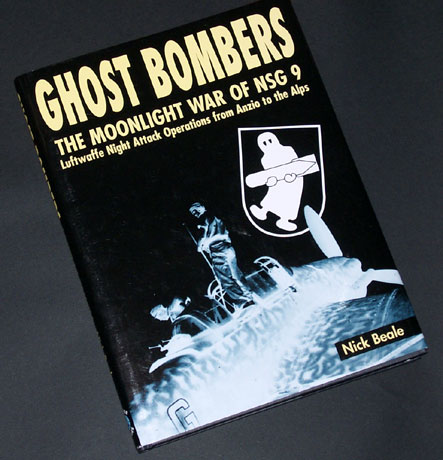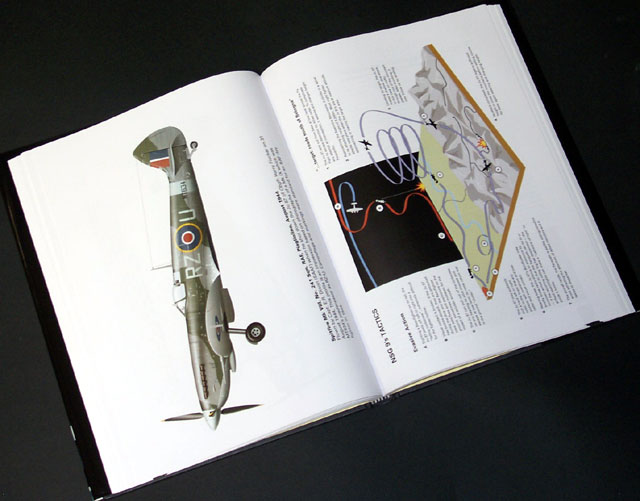|
Ghost Bombers
The
Moonlight War of NSG 9
Luftwaffe
Night Attack Operations
from Anzio to the Alps
By Nick Beale

Classic Publications
S u m m a r y
|
| ISBN: |
1-903223-15-6 |
| Media: |
Hardback with glossy dust cover; 300mm x
224mm in portrait format; 208 pages; over 150 photographs; 20 colour
profiles; tables; technical drawings. |
| Price: |
£24.95 plus shipping,
online from Classic
Publications |
| Review Type: |
First Read |
| Advantages: |
Comprehensive text and photo
coverage of this unit's formation, aircraft and operations;
beautiful colour profiles of German, Italian and Allied aircraft;
excellent layout - broken up by tables and sidebars; Appendices
with victories, loss reports and Order of Battle. |
| Disadvantages: |
|
| Recommendation: |
Recommended for all Luftwaffe
history buffs or modellers |
Reviewed by Brett Green

HyperScale is proudly supported by Squadron.com
Nick Beale is co-author of the excellent book, "Air War
Italy". His latest title, "Ghost Bombers - The
Moonlight War of NSG 9" is a logical extension of the subject
matter in the earlier book.
NSG 9 was a Luftwaffe ground attack unit formed in 1943 to perform
nuisance bombing at night. This tactic was based on very successful
Soviet night operations using obsolete aircraft during the winter of
1941 and 1942. Although the Soviet biplanes caused minimal material
damage, the bombing deprived German troops of much-needed sleep - an
essential resource during the intense fighting on the Eastern Front.
In late 1943, NSG 9 transferred to Italy. The unit initially operated
Italian types including the Fiat CR.42 and the widely disliked Caproni
314. By the end of January 1944, the unit started training with the slow
but reliable Ju 87 Stuka.
The debut of NSG 9 at Anzio made little impact, but later
operations were more successful and the unit was greatly appreciated by
German ground troops. However, heavy casualties were suffered by the
cumbersome Stukas at the hands of Allied Mosquitoes and Beaufighters.

The text of "Ghost Bombers" is logically structured,
interesting and informative. The chapters are peppered with tables and
sidebars providing related information such as statistics or a pilot's
personal viewpoint. This format ensures that the reading never becomes
too heavy despite the relative bulk of the book.
In common with Classic Publications other releases, more than 150
photos are a valuable aid to telling this story. Captions are also very
useful.
Tom Tullis' artwork is another highlight. Tom tries his hand with a
few different subjects in this book, including the Arado Ar 66, Caproni
Ca.314, Junkers W.34, Fiesler Storch, Fw 190F-8/R1, Fiat CR.42,
Beaufighter, Mustang, Spitfire and, of course, Stukas. All 20 profiles
are handled with Tom's typically realistic approach to light and shade.
Camouflage colours look very convincing too.
The book is rounded out with four Appendices - Markings and
Camouflage; Allied Victory Claims; NSG 9 Loss Reports and NSG 9 Order of
Battle, 31 December 1943 to 22 April 1945.
"Ghost Bombers - The Moonlight War of NSG 9" is an
excellent reference source about the aircraft and operations of this
little-known but fascinating Luftwaffe unit. I am sure it will be
appreciated equally by modellers and Luftwaffe historians.
Recommended.
Nick Beale's "Ghost
Bombers", and other Classic books, may be purchased through
specialist bookstores worldwide or from
Classic Publications Website
Review Copyright © 2001 by
Brett Green
This Page Created on 31 December, 2001
Last updated
22 July, 2003
Back to
HyperScale Main Page
Back to
Reviews Page |
Home | What's
New | Features
| Gallery |
Reviews | Reference
| Forum
| Search